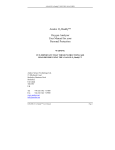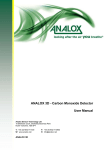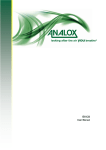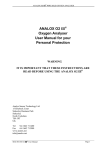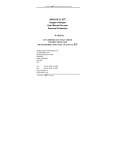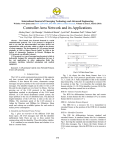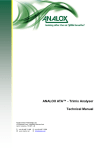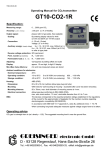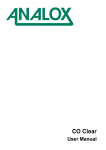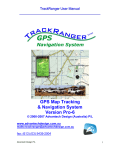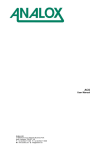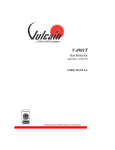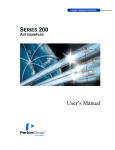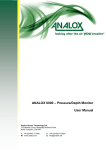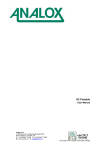Download User Manual
Transcript
EII CO User Manual Analox Ltd 15 Ellerbeck Court, Stokesley Business Park North Yorkshire, TS9 5PT, UK T: +44 (0)1642 711400 F: +44 (0)1642 713900 W: www.analox.net E: [email protected] This support line is closed on UK public holidays EII CO User Manual List of Contents 1 Introduction .............................................................................................................. 6 Package Content .................................................................................................. 6 About the EII CO .................................................................................................. 6 2 Operation ................................................................................................................. 7 2.1 Switching On ........................................................................................................ 7 2.2 Freezing the Dis play ............................................................................................. 7 2.3 Switching off......................................................................................................... 7 2.4 Low battery indic ation ........................................................................................... 7 2.5 Checking your Tank .............................................................................................. 8 2.6 Maximum allowable CO expos ure levels ................................................................ 9 3 Pre-use checks........................................................................................................10 3.1 Zero set ..............................................................................................................10 3.2 Bump testing .......................................................................................................11 4 Helium sensitivity effect ............................................................................................13 5 Troubleshooting.......................................................................................................15 6 Maintenance............................................................................................................16 6.1 Battery replacement .............................................................................................16 6.2 Sensor replacement .............................................................................................16 6.3 General care .......................................................................................................18 6.4 Sensor handling information .................................................................................18 7 Calibration...............................................................................................................19 7.1 Span calibration...................................................................................................19 7.2 Calibration using the zero calibration kit ................................................................19 8 Safety information....................................................................................................21 9 Warranty information................................................................................................22 10 Specifications after factory calibration .......................................................................23 10.1 Specifications using bump test and zero set only ...............................................23 11 Spares ....................................................................................................................24 12 Disposal ..................................................................................................................25 13 Declaration of Conformity .........................................................................................26 1.1 1.2 Document Ref: P0107-800-06 - September 2013 Page 4 EII CO User Manual Document Ref: P0107-800-06 - September 2013 Page 5 EII CO User Manual 1 1.1 Introduction Package Content On opening your Analox EII CO, please check you have the following items. a) b) c) d) EII CO Sampling dome User manual Any accessories ordered for your EII CO, from: • Storage Case • Bump Testing Gas Kit (10 ppm CO Aerosol) 1.2 About the EII CO The EII CO carbon monoxide (CO) analyser is designed to measure CO levels in the range 0 to 50ppm for tank CO level checking. The EII CO is ergonomically designed, and equipped with several features to ensure ease of use and reliability. The instrument has been designed to be held in the left hand to facilitate checking your tank. It is fitted with a large digital display and incorporates an internal electrochemical carbon monoxide sensor. Power is provided by a 9V battery which will last for approximately 1 year before replacement is necessary. The EII CO will automatically switch off after 10 minutes to ensure battery life is not compromised if the instrument is accidentally turned on. The EII CO is water and drop resistant. Designed specifically for the diving industry – whether you may be a Sport, Commercial or Military diver - where hostile environmental conditions are the norm not the exception. Your EII CO is supplied ready to use, all you need to do is push in the sampling dome. Document Ref: P0107-800-06 - September 2013 Page 6 EII CO User Manual 2 2.1 Operation Switching On The analyser is fitted with an ‘ON’ button located on the side of the unit when held in your left hand the button should sit comfortably under your thumb. To turn the unit on press the button once; the analyser's display will now show a carbon monoxide reading in parts per million (ppm). Do not use the EII CO before calibration (see Section 3). Switch On 2.2 Freezing the Display In use, the ‘ON’ button also acts as a ‘HOLD’ button to allow the instrument to be removed from the tank for easier reading without losing the measured gas concentration. Press once to freeze the current reading on the display (a frozen reading is indicated by a ‘:’ symbol being shown) Reading held Press again to cancel and continue measuring: Reading released (monitoring ambient CO) 2.3 Switching off The EII CO will automatically switch off after 10 minutes to prevent the battery from being drained if the unit is accidentally switched on. 2.4 Low battery indication The low battery warning is shown by an ‘L’ on the display, indicating that the battery must be changed before using the instrument (see Section 6.1). ‘L’ Low battery symbol WARNING Do NOT use when the LOW BATTERY symbol is displayed! Document Ref: P0107-800-06 - September 2013 Page 7 EII CO User Manual 2.5 Checking your Tank The EII CO comes complete with a unique sampling dome which allows you to directly apply the analyser to the outlet on your tank. 1. Ensure that the span calibration of the device is within date (within 6 months) 2. Ensure that the instrument has been zero calibrated (see section 3.1) and bump tested (see section 3.2) before checking your tank. 3. Push the sampling dome into the sensor aperture. 4. Very slowly open the pillar valve with your right hand until the hiss of gas escaping can just be heard. WARNING: Open tank valve EXTREMELY CAREFULLY before applying the EII CO Eye protection should be worn during this procedure 5. Hold the EII CO in your left hand and press the sampling dome firmly against the tank outlet. Take a direct reading from your tank 6. Close the pillar valve after thirty seconds when a stable reading is observed on the EII CO. 7. If in doubt repeat the procedure taking care to ensure a very low gas flow. 8. For ease of use, the EII CO is fitted with a hold feature. Once a stable reading has been observed, press the ‘ON’ button to hold this reading. The EII CO can then be moved away from the tank to enable you to record the CO reading. To cancel the reading, press the ‘ON’ button again. Document Ref: P0107-800-06 - September 2013 Page 8 EII CO User Manual Reading held 9. It is important to note that after a few seconds of the gas flow being stopped the reading will begin to change towards the level in the surrounding air (0ppm CO) you should therefore take the reading or press the hold button while flow is ON. NOTE: When the EII CO is used to measure the carbon monoxide in a heliox or trimix gas a helium compensation factor should be applied to the measured value. See section 4 for details of the helium sensitivity effect and how to apply the helium compensation factor. WARNING Very high flows may pressurise the sensor and inaccurate readings or sensor damage will result. 2.6 Maximum allowable CO exposure levels The maximum allowable CO exposure levels for air diving vary in the standards set form one country to another, so you may want to consider referring to the applicable safety standards for your county to determine your maximum allowable CO exposure level. However, Analox advises that the maximum allowable CO exposure levels should be to that stated in the British Health and Safety Executive (HSE) DVIS9(rev1) document (Diver’s breathing air standard and the frequency of examination and tests (Diving Information Sheet No 9 (Revision 1)). This states that: Carbon monoxide content shall be as low as possible but not exceed 3 ppm. (For air diving to 50metres) Document Ref: P0107-800-06 - September 2013 Page 9 EII CO User Manual 3 Pre-use checks WARNING Do not leave the analyser in direct sunlight, this may result in the analyser failing the Zero set calibration. 3.1 Zero set Zero calibration (performed in clean air) is essential before every use and is performed as follows. 1. Expose the analyser (with sampling dome disconnected) to clean air for two minutes and adjust the calibration knob until the display reads 0ppm. If this is not possible refer to Section 5. Calibration in clean air The analyser is now ready for bump testing. SAFETY WARNING It is of vital importance that the zero calibration is performed with a source of clean air. Just because a calibration is performed in the open air on board a boat it should not be assumed that the air is clean. Due to backdrafting, or the 'Station Wagon' effect, accumulation of carbon monoxide can occur in the cabin or aft deck, even in an open area. Air flow Low pressure area created at rear of boat pulling exhaust fumes back in to the boat Document Ref: P0107-800-06 - September 2013 Page 10 EII CO User Manual This effect occurs as air moves around a boat and forms a low pressure area behind it that tends to pull exhaust fumes back into the boat. If the EII CO is calibrated using this already contaminated air it will result in false tank gas measurements. Users should be aware of this and should take appropriate measures to ensure a clean air source is used when performing a zero calibration as the accuracy of the measurement of the breathing air tank is only as accurate as the initial calibration. The risk of air contamination does not only exist when the boat is moving at speed, it can also be encountered with the boat moving at slow speed or idling. The air in your boat can also be contaminated by another vessel’s exhaust that is alongside and even if you are moored near another vessel. To ensure the accuracy of the zero calibration the following should be considered: 1. Check the contents of your gas cylinders before boarding the boat 2. Use a known clean source of air to pass a flow directly over the sensor using the push-in calibration adaptor 3. Calibrate the EII CO using the zero calibration kit (see section 7.2) 3.2 Bump testing A ’bump’ test is a means of verifying that the instrument is working within acceptable limits by briefly exposing to a known gas mixture formulated to change the output of the sensor. This is different from a calibration where the instrument is also exposed to a known gas mixture but is allowed to settle to a steady figure and the reading adjusted to the stated gas concentration of the test mixture. You can bump test your EII CO utilizing one of the follow methods: The first of which, and preferred method, utilizes a 10 ppm bump gas. The second method permits the use of your breath when traditional bump gas is not available. Bump testing of the device is necessary to ensure correct response to carbon monoxide gas. 3.2.1 Traditional bump test 1. Power the EII CO up and set the display to zero 2. Directing the nozzle tube of the bump test gas aerosol into dome aperture, spray the bump test gas for 5 seconds. Document Ref: P0107-800-06 - September 2013 Page 11 EII CO User Manual 3. Ensure that the displayed reading rises above 7ppm but below 13ppm CO 4. If bump testing fails to raise the display reading sufficiently, ensure that sufficient gas remains in the bump test kit. Please see Section 5 for further troubleshooting information. 3.2.2 Bump test your EII CO with your breath 1. Power the EII CO up and set the display to zero 2. Take a deep breath and hold it for 5 to 10 seconds 3. With the dome adaptor removed, exhale a slow and even breath into the dome aperture 4. Ensure that the displayed reading rises to 1 to 2ppm (smokers may see a higher sensor response) 5. If breath testing fails to raise the display reading sufficiently, then a traditional bump test should be performed as per section 3.2.1. Please see Section 5 for further troubleshooting information. Document Ref: P0107-800-06 - September 2013 Page 12 EII CO User Manual 4 Helium sensitivity effect The carbon monoxide sensor used in the EII CO is a capilliary type sensor. These types of sensors are affected by the presence of helium (He), and in such cases give higher than anticipated outputs. The reason for this phenomenon is due to the small size of the helium molecule. When present in high concentration the helium molecules diffuse rapidly through the capillary into the carbon monoxide sensor and at the same time allowing more rapid diffusion of the much larger carbon monoxide (CO) molecules. The result of this process is that as the concentration of helium increases a greater number of carbon monoxide molecules enter the sensor which results in artificially high readings. For this reason a helium compensation factor should be applied to the measured value of carbon monoxide when measuring heliox or trimix gas. The effect of the presence of helium in the sample gas is to increase the carbon monoxide cell sensitivity. This means that as the amount of helium increases to its typical maximum level (typically 99% He in a saturation diving application) the sensitivity of the CO cell increases by a factor of approximately 2.31 (typical). So, if 6ppm carbon monoxide was measured in a tank containing 99% He, the actual content would be 3ppm (6/2.31 = 2.60ppm). The chart below (Figure 1) shows the typical helium sensitivity effect across a helium content range of 1% to 99%, which is the typical range of Helium content used in diving applications. Helium sensitivity effect 2.50 Heliox and Trimix gas testing W hen testing heliox and trimix gas mixtures the helium content will vary according to the particular mix that is required. Therefore, the helium compensation factor applied to the measured carbon monoxide content will vary accordingly. For example, a gas mix with 99% helium content has a helium compensation factor of 2.31. This means that the content of carbon monoxide measured will be larger that the actual carbon monoxide content by a factor of 2.31. So, if 6ppm carbon monoxide was measured in this tank the actual content would be 3ppm (6/2.31 = 2.60ppm). Helium compensation factor 2.00 99, 2.31 1.50 0, 1.00 1.00 He compensation factor Nitrox gas testing W hen testing nitriox gas mixtures the helium compensation factor is 1.00 as no helium is present in the gas mix. 0.50 0.00 0 10 20 30 40 50 Helium content (%) 60 70 80 90 Figure 1 The chart shows that as the % of He increases it has the effect that the displayed measured value will be greater than the actual carbon monoxide content in the mix. This ensures that any inaccuracies are ‘fail-safe’. Document Ref: P0107-800-06 - September 2013 Page 13 100 EII CO User Manual The look-up table below (Figure 2) shows a simplified representation of this data to quickly identify the compensation factor to be applied to you tank gas measurement. % Helium in mix Compensation factor 0 to 17 17 to 31 31 to 42 42 to 52 52 to 60 60 to 66 66 to 78 78 to 83 83 to 89 89 to 95 95 to 99 1.0 1.1 1.2 1.3 1.4 1.5 1.6 1.8 1.9 2.0 2.2 Figure 2 Document Ref: P0107-800-06 - September 2013 Page 14 EII CO User Manual 5 Troubleshooting SYMPTOM CONDITION ACTION ‘L’ symbol No display Low battery Switched off Poor battery connection Bump test fail Sensor expired Incorrect bump gas Calibration expired Bump test gas exhausted Not enough adjustment on calibration knob to zero display Tank gas measurement taken is reading negative Reading erratic Reading does not change when calibration knob is turned Display segments missing Will not calibrate Reading drifts Ambient air contaminated is Reading held Sensor failure Faulty connections EII CO calibrated using Contaminated air Change battery Switch on Check battery connection Return to supplier Please refer to website Ensure bump gas is 10ppm CO (as supplied by Analox) Contact an Analox approved service centre or purchase a calibration kit. Contact Analox to purchase a new bump test kit (A bump test kit should supply around 20 bump tests) Perform the zero set procedure (section 3.1) again in clean air or calibrate using the Zero Calibration Kit (section 7.2) Pressure on sensor Radio interference Sensor old or faulty Condensation on sensor Reading held Sensor failure Faulty connections Press ‘ON’ button to unfreeze Change sensor Return to supplier Perform the zero set procedure (section 3.1) again in clean air or calibrate using the zero calibration kit (section 7.2) Reduce gas flow rate Move unit away from any radio equipment Change sensor Shake water off sensor face Press ‘ON’ button to unfreeze Change sensor Return to supplier Display faulty Return to supplier Sensor faulty Sensor not in air Rapid temperature change Change sensor Check sample dome is not fitted Do not move analyser from one temperature to another immediately before use Document Ref: P0107-800-06 - September 2013 Page 15 EII CO User Manual 6 Maintenance 6.1 Battery replacement 1. Loosen the 4 screws located on the front cover. The gasket seal is designed to prevent water leaking into the EII CO so the seal may be tight. Loosen the seal by moving the lid from side to side, and then carefully lift the cover. 2. Slide the battery out of its holder and disconnect the lead. 3. Connect the lead to the new battery and slide the battery into its holder, under the battery clip 4. Replace the cover carefully taking care that the sensor locates properly, and that no wires are trapped. Screw down until you feel the gasket compress; do not over tighten the screws. 6.2 Sensor replacement 1. Replacement part number for your sensor is: 9100-1700A 2. Remove the sampling dome and loosen the 4 screws located on the front cover. The gasket seal is designed to prevent water leaking into the EII CO so the seal may be tight. Loosen the seal by moving the lid from side to side, and then and carefully lift the cover. Document Ref: P0107-800-06 - September 2013 Page 16 EII CO User Manual 3. Unplug the connector from the back of the sensor. 4. Unscrew the sensor from the front cover. 5. Dispose of the old sensor according to local regulations for acidic compounds. 6. Remove the new sensor from its pack and check it for leaks (see section 7 for safety information), check the sensor has a rubber o-ring fitted at the base of the thread on the front of the sensor. Screw the sensor into the front cover tightly and connect to the EII connector. Align the metal sockets on the connector with the pins of the sensor and push on firmly. O-ring 7. Replace the cover carefully, ensuring that the sensor locates properly and that no wires are trapped. Screw down until you feel the gasket compress; do not over tighten the screws. 8. Push on the sampling dome. NOTE: When a new sensor is fitted a full calibration MUST be performed, see section 7 for details of calibration and section 11 for details of calibration kits available. Document Ref: P0107-800-06 - September 2013 Page 17 EII CO User Manual 6.3 General care Although designed to be water resistant the EII CO should not be intentionally immersed in liquid or left outside unprotected. The EII CO is built to resist the effects of day to day shocks and drops but remember it is an electronic measurement device and should be looked after carefully to give long trouble free service. To clean the EII CO use a damp soft cloth. Protect the EII CO from long periods of direct sunlight and do not subject it to high or low temperature extremes. The sensor in the EII CO is an electrochemical device and contains an acidic electrolyte. Always check to make sure that it is not leaking (see section 8 for safety information). In the event that you do come into contact with the electrolyte wash the contaminated part with copious amounts of water see Section 8. 6.4 Sensor handling information EII CO carbon monoxide sensors are normally supplied in sealed packs. Before the pack is opened, check that the sensor has not leaked. The sensors are themselves sealed and do not under normal circumstances present a health hazard however if leakage of the electrolyte has occurred use rubber gloves and wear chemical splash goggles to handle and clean up. Rinse contaminated surfaces with water. If anybody comes into contact with the electrolyte, please refer to Section 8. Document Ref: P0107-800-06 - September 2013 Page 18 EII CO User Manual 7 Calibration 7.1 Span calibration To meet the factory calibration specifications given in section 10, span calibration is required every six months (See section 11 for details of calibration kits available). For reduced accuracy operation, the EII CO can be used as a Go/No Go tester provided that the unit passes a zero set and bump test as specified in section 3 Alternatively, contact an Analox approved service centre for span calibration. A full list of service centres can be found on the Analox website (www.analox.net) 7.2 Calibration using the zero calibration kit If in doubt that the ambient air where the EII CO is in use is clean (i.e. free of carbon monoxide) then the zero calibration gas kit, together with the calibration tool kit (see section 11), should be used to ensure an accurate calibration and maintain safe diving. 1. Screw the flow indicator on to the zero calibration cylinder (synthetic air) and fit the flow adaptor to the tubing 2. Remove the sample dome from the EII CO and push the push-in calibration adaptor in to the sample dome aperture. Press the ON button to switch the EII CO on. Ensure the EII CO display hold function is not active. Flow adaptor fitted 3. Open the control valve of the flow indicator to set the flow indication ball between the two markers. Allow the gas to flow over the sensor until the display reading is settled. This should take no more than 2 minutes. Document Ref: P0107-800-06 - September 2013 Page 19 EII CO User Manual Flow indicator set Flow markers 4. Adjust the calibration knob until the display reads 0ppm. If this is not possible refer to Section 5. Display set to ‘000’ 5. Close the air gas cylinder, remove the push-in calibration adaptor and re-fit the sample dome. The analyser is now ready for bump testing Document Ref: P0107-800-06 - September 2013 Page 20 EII CO User Manual 8 Safety information When the life of the battery has expired it should be disposed of safely in accordance with local regulations. When the life of the sensor has expired or it is leaking or otherwise damaged it must be disposed of safely in accordance with local regulations. The sensor contains an acidic electrolyte which is hazardous. In the event of an accident, use the following first aid procedures Body Part Skin Effect First Aid Procedures Contact could result in a chemical burn. Immediately flush the skin thoroughly with water for at least 15 minutes. Persons with pre-existing skin disorders may be more susceptible to the effects of the substance. Ingestion Eye Corrosive. May cause sore throat, abdominal pain, nausea, and severe burns of the mouth, throat, and stomach, and may be fatal. Persons with pre-existing eye problems may be more susceptible to the effects of the substance. Remove contaminated before re-use. clothing and wash Obtain medical advice if continued irritation. If swallowed DO NOT INDUCE VOMITING. Wash out mouth thoroughly with water and give plenty of water to drink. Obtain medical advice immediately Irrigate thoroughly with water for at least 15 minutes. Obtain medical advice immediately. Corrosive. May cause redness, pain, blurred vision, and eye burns. Inhalation Contact can result in the permanent loss of sight. Persons with pre-existing impaired respiratory function may be more susceptible to the effects of the substance. Remove to fresh air. Rest and keep warm. Obtain medical advice if applicable. Inhalation is not an expected hazard unless heated to high temperatures. Mist or vapour inhalation can cause irritation to the nose, throat, and upper respiratory tract. Document Ref: P0107-800-06 - September 2013 Page 21 EII CO User Manual 9 W arranty information We provide the following Warranties for the EII CO : A 3 year electronics warranty. A 1 year sensor warranty. In both cases the Warranty period runs from the date of our invoice. We warrant that the equipment will be free from defects in workmanship and materials. The warranty does not extend to and we will not be liable for defects caused by the effects of normal wear and tear, erosion, corrosion, fire, explosion, misuse, use in any context or application for which the equipment is not designed or recommended, or unauthorised modification. Following a valid warranty claim in accordance with the above, the equipment, upon return to us, would be repaired or replaced without cost or charge but in our discretion we may elect instead to provide to you which ever is the lesser of the cost of replacement or a refund of net purchase price paid as per our Invoice on initial purchase from us. We shall have no liability for losses, damages, costs or delays whatsoever. We shall have no liability for any incidental or consequential losses or damages. All express or implied warranties as to satisfactory or merchantable quality, fitness for a particular or general purpose or otherwise are excluded and no such Warranties are made or provided, save as set out in this Clause 7. In order to effectively notify a Warranty claim, the claim with all relevant information and documentation should be sent in writing to: Analox Ltd 15 Ellerbeck Court Stokesley Business Park Stokesley North Yorkshire TS9 5PT Or by e-mail to : [email protected] Or by Fax to : +44 1642 713900 We reserve the right to require from you proof of dispatch to us of the notification of warranty claim by any of the above alternative means. The equipment should not be sent to us without our prior written authority. All shipping and Insurance costs of returned equipment are to be born by you and at your risk. All returned items must be properly and sufficiently packed. Document Ref: P0107-800-06 - September 2013 Page 22 EII CO User Manual 10 Specifications after factory calibration Range Accuracy Resolution Warm up time Response time (T90) Sensor type Sensor life Battery Battery life Operating temp Storage temp Pressure Temperature effect Calibration gas flow rate Weight Dimensions Ingress protection 0 to 50ppmCO ±(0.5ppm CO + 5% reading ) 1ppm CO < 5 seconds < 20 seconds Analox 9100-1700A type electrochemical sensor 2 years in air 1 year warranty 9V Alkaline (PP3) Approximately 1 year -5 to 50°C / 23 to 122°F -20 to 50°C / -4 to 122°F 1013mbar ± 10% <2 ppm CO/°C (<1.1 ppm CO/ °F) 0.5 to 1.0 litres/minute 225g / 8oz 130 (l) x 70 (w) x 55 (d) mm 5 ¼ (l) x 2 ¾ (w) x 2 ¼ (d) inches IP65/ NEMA 4 If you have any comments or queries about the EII CO please contact us; Tel: +44 1642 711400 Fax: +44 1642 713900 Email: [email protected] Website www.analox.net 10.1 Specifications using bump test and zero set only Accuracy +/- 1 digit up to 10ppm CO Document Ref: P0107-800-06 - September 2013 Page 23 EII CO User Manual 11 Spares The EII CO can be supplied with any of the following accessories; Item Description Storage case; compact water proof case ideal for protecting your EII CO. Bump test gas kit Part Number SA2EIIMINICASE SA7CAN510 10ppm CO in balance air Providing around 20 bump tests from a standard bump test kit. Span calibration gas cylinder SA7EIICOCALKIT 10ppm Carbon monoxide in balance air Zero calibration gas cylinder SA7EIICOZCALKIT Synthetic air 21% oxygen balance nitrogen Calibration tool kit Comprising: Trimming tool T10 torx driver Flow indicator for gas bottles EII CO push-in cal adaptor EII CO calibration DVD Analox 500Mb USB stick Document Ref: P0107-800-06 - September 2013 Page 24 SA7EIICOTOOLKIT EII CO User Manual 12 Disposal According to WEEE regulation this electronic product can not be placed in household waste bins. Please check local regulations for information on the disposal of electronic products in your area. Document Ref: P0107-800-06 - September 2013 Page 25 EII CO User Manual 13 Declaration of Conformity DECLARATION OF CONFORMITY Number: Manufacturers name: Manufacturers address: P0107-903-00 Analox Sensor Technology Ltd 15 Ellerbeck Court Stokesley Business Park Stokesley England TS9 5PT It is declared that the following product: Product name: Product code: Conforms to all applicable requirements of: Analox EII CO EII CO BS EN 61000-6-1, BS EN 61000-6-3, IEC/EN 61010-1:2001 (2nd ed) BS EN 60529 IP6X The above product complies with the requirements of the EMC Directive 89/336/EEC, as amended. The above product complies with the requirements of the Low Voltage Directive 73/23/EEC, as amended. Signed on behalf of: Date: Analox Sensor Technology Ltd 01st December 2010 Signed: Name: Position: Mark Lewis Managing Director SA127 Issue 2 September 2006 Document Ref: P0107-800-06 - September 2013 Page 26

























